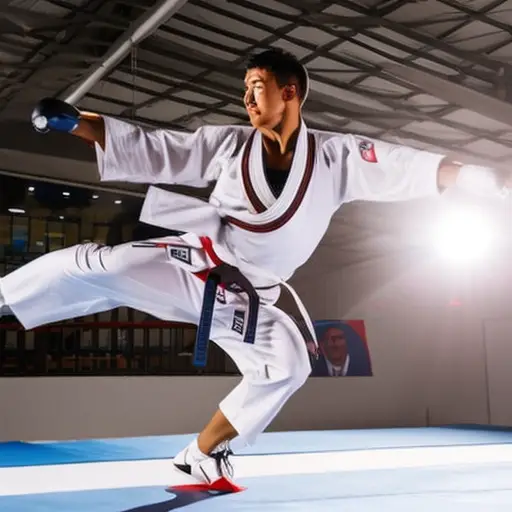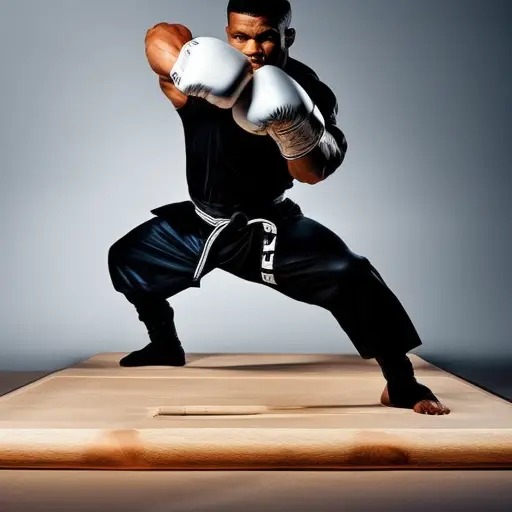Taekwondo in the Olympics: A Look at Competitive Sparring

Take a tantalizing tour into the thrilling realm of Taekwondo in the Olympics, where competitive sparring takes center stage.
This article delves into the historical backdrop, rules and regulations, training methods, strategic approaches, and noteworthy athletes that have graced the Olympic stage.
As we embark on this journey, prepare to witness the power, precision, and passion that define this captivating martial art in the quest for gold.
The History of Taekwondo in the Olympics
When did Taekwondo first become an Olympic sport? Taekwondo made its debut as an official Olympic sport at the Sydney 2000 Olympic Games. This marked a significant milestone in the evolution of Taekwondo in the Olympics and showcased the impact of Taekwondo in the Olympic movement.
The inclusion of Taekwondo in the Olympics was a result of the sport’s growing popularity and global reach. Taekwondo’s emphasis on precision, agility, and explosive kicks made it an exciting addition to the Olympic program. It also allowed for greater representation from Asian countries, where Taekwondo is deeply rooted.
Since its introduction, Taekwondo has continued to thrive in the Olympic Games, attracting participants from all over the world. The sport has evolved, with the introduction of electronic scoring systems and modifications to the competition format. These changes have aimed to enhance the fairness and transparency of judging in Taekwondo competitions.
The presence of Taekwondo in the Olympics has not only provided athletes with the opportunity to showcase their skills on a global stage but has also contributed to the promotion of the sport and its values of discipline, respect, and perseverance. As we delve into the subsequent section about the rules and regulations of competitive sparring, we will explore how these principles are upheld in the Olympic Taekwondo arena.
The Rules and Regulations of Competitive Sparring
Furthermore, competitors in Taekwondo’s competitive sparring must adhere to a set of rules and regulations that govern the conduct and techniques allowed during matches. These rules are put in place to ensure fair play, safety, and consistency in the sport. The World Taekwondo Federation (WTF), the international governing body for Taekwondo, has established a comprehensive set of rules for competitive sparring.
One of the key aspects of competitive sparring is the use of specific Taekwondo sparring techniques. These techniques include punches, kicks, and strikes, which must be executed with precision and control. Competitors are awarded points for clean and accurate techniques that land on specific target areas of their opponent’s body.
To help the audience understand the scoring system, here is a table that outlines the point distribution:
| Technique | Point Value |
|---|---|
| Punch to trunk | 1 point |
| Kick to trunk | 2 points |
| Kick to head | 3 points |
| Spinning kick | 4 points |
| Jumping kick | 5 points |
In addition to the scoring system, there are also penalties for certain actions or fouls committed during a match. These penalties can result in deductions of points or even disqualification. Some common penalties include excessive contact, falling, stepping out of bounds, and misconduct.
Training and Conditioning for Olympic Taekwondo Sparring
Competitors’ training and conditioning are essential for success in Olympic Taekwondo sparring. They require a combination of physical strength, agility, speed, and mental focus. To develop these attributes, athletes engage in specific training programs that include plyometric exercises and mental preparation.
Plyometric exercises are a key component of a taekwondo athlete’s training regimen. These exercises aim to improve explosive power, speed, and agility. Examples of plyometric exercises include box jumps, depth jumps, and medicine ball throws. By incorporating these exercises into their training routine, athletes can enhance their ability to execute fast and powerful kicks and punches, giving them an advantage in the sparring ring.
In addition to physical conditioning, mental preparation is crucial for success in Olympic Taekwondo sparring. Athletes must maintain focus and composure under pressure, as well as develop effective strategies to outwit their opponents. Mental training techniques such as visualization, meditation, and goal-setting are commonly used to improve concentration, confidence, and decision-making skills. By honing their mental strength, athletes can stay calm and focused during intense matches, enabling them to react quickly and effectively to their opponent’s movements.
Strategies and Tactics Used in Competitive Sparring
Moreover, practitioners of taekwondo employ various strategies and tactics in competitive sparring to gain an advantage over their opponents. In taekwondo, both offensive and defensive techniques are crucial for success in sparring.
Defensive techniques in taekwondo sparring are aimed at protecting oneself from the opponent’s attacks. These techniques include blocking, evading, and countering. Blocking involves using the arms and legs to intercept or deflect the opponent’s strikes, while evading involves moving the body out of the way to avoid getting hit. Countering is a defensive tactic where the practitioner takes advantage of the opponent’s attack by swiftly retaliating with a strike of their own.
On the other hand, offensive techniques in taekwondo sparring are aimed at scoring points by landing strikes on the opponent. Kicks and punches are the primary offensive techniques used in taekwondo sparring. Practitioners utilize a wide range of kicks, such as front kicks, roundhouse kicks, and side kicks, to target their opponent’s scoring zones. Punches, although less commonly used, can also be effective when executed accurately.
In addition to these techniques, taekwondo practitioners employ various strategies to outsmart their opponents. These strategies often involve analyzing the opponent’s movements and adapting accordingly. Some common strategies include feinting, which involves deceiving the opponent with a false attack, and timing, which involves striking at the precise moment when the opponent is vulnerable.
Notable Moments and Athletes in Olympic Taekwondo Sparring
While taekwondo has been a part of the Olympic Games since 2000, there have been several notable moments and athletes that have left a lasting impact on the sport’s competitive sparring division. These Olympic taekwondo moments and athletes have showcased the skill, dedication, and determination required to excel in this dynamic martial art.
One of the most memorable Olympic taekwondo moments occurred at the 2008 Beijing Olympics when Steven Lopez of the United States won his third Olympic gold medal in the men’s welterweight division. Lopez became the first taekwondo athlete to achieve this feat, solidifying his status as a legend in the sport.
Another notable Olympic taekwondo athlete is Jade Jones from Great Britain. Jones made history at the 2012 London Olympics by becoming the first British athlete to win gold in taekwondo. She went on to defend her title in the women’s featherweight division at the 2016 Rio Olympics, cementing her status as one of the sport’s greatest athletes.
To provide a visual representation of the impact these moments and athletes have had, the following table showcases some of the most notable Olympic taekwondo moments and athletes:
| Year | Olympic Taekwondo Moment | Olympic Taekwondo Athlete |
|---|---|---|
| 2008 | Steven Lopez wins third Olympic gold medal | Steven Lopez (USA) |
| 2012 | Jade Jones becomes first British taekwondo gold medalist | Jade Jones (GBR) |
| 2016 | Jade Jones defends her Olympic title | Jade Jones (GBR) |
| 2021 | TBD | TBD |
These Olympic taekwondo moments and athletes have not only brought glory to their respective countries but have also inspired future generations of taekwondo practitioners to strive for excellence in the competitive sparring division.
Frequently Asked Questions
How Many Weight Categories Are There in Olympic Taekwondo Sparring?
There are a total of eight weight categories in Olympic Taekwondo sparring. These categories are divided based on the athletes’ weight, with each category having its own set of strategies and techniques.
What Are the Penalties for Illegal Techniques in Olympic Taekwondo Sparring?
In Olympic taekwondo sparring, penalties for illegal techniques are enforced to ensure fair play and safety. These penalties may include point deductions, warnings, or even disqualification. Upholding sportsmanship is of utmost importance in taekwondo competition.
Are There Any Age Restrictions for Participating in Olympic Taekwondo Sparring?
Age limitations for Olympic taekwondo sparring are determined by the International Olympic Committee and the World Taekwondo Federation. Athletes must be at least 17 years old to compete. Training techniques focus on developing agility, strength, and precision.
How Are Winners Determined in Olympic Taekwondo Sparring Matches?
In Olympic taekwondo sparring matches, winners are determined through a complex scoring system that rewards precise and powerful kicks and punches. Athletes employ various strategies and tactics to outmaneuver their opponents, while also dealing with the psychological pressures of competing at the highest level.
Can Athletes From Different Countries Train Together for Olympic Taekwondo Sparring?
Training partnerships in Olympic taekwondo sparring can involve athletes from different countries. These partnerships facilitate cultural exchange, allowing athletes to learn from each other’s techniques and strategies, enhancing their overall skills and competitiveness.
Conclusion
In conclusion, competitive sparring in Olympic Taekwondo is a dynamic and thrilling display of skill, strategy, and athleticism. With a rich history and a set of strict rules and regulations, athletes undergo rigorous training and conditioning to prepare for this intense sport.
Notable moments and athletes have left a lasting impact on the sport, contributing to its popularity and success in the Olympic Games. Taekwondo in the Olympics continues to captivate audiences with its impressive displays of strength, speed, and precision.





